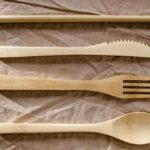Cutlery refers to a set of tools used for cutting and eating food, such as knives, forks, and spoons. Here are 8 tips to help you up your cutlery game:
- Invest in quality: Look for cutlery made from durable materials such as stainless steel, silver or titanium, as these will last longer and perform better.
- Choose the right knife for the job: Different knives have different uses, such as a chef’s knife for chopping, a paring knife for peeling, and a bread knife for slicing.
- Maintain your cutlery: Wash and dry your cutlery properly after each use and store it safely to prevent damage.
- Learn proper table setting etiquette: Know the correct way to set a table, including the placement of knives, forks, and spoons.
- Use utensils correctly: Hold knives, forks and spoons correctly, as this will make eating easier and more enjoyable.
- Experiment with different types of cutlery: Try different types of cutlery, such as chopsticks, for a new dining experience.
- Add to your collection: Look for unique or decorative pieces to add to your cutlery collection, such as carved or embellished handles.
- Experiment with different materials: Try cutlery made from alternative materials such as bamboo, wood, or bone to experience different textures and weights.
What are the different types of cutlery?

The different types of cutlery include:
Knives: including chef’s knife, paring knife, bread knife, serrated knife, boning knife, utility knife, and many others.
Forks: including dinner fork, salad fork, dessert fork, and others.
Spoons: including teaspoon, tablespoon, soup spoon, dessert spoon, and others.
Other types: such as chopsticks, serving utensils, and specialty items such as seafood forks, asparagus tongs, and so on.
These types of cutlery vary in design, size, and usage depending on the type of food being served and the culture in which they are used.
How to set cutlery on table?
Here’s a guide to setting cutlery on a table:
Start with the outermost utensils and work inward: Place the dinner fork on the left of the plate, followed by the knife and spoon on the right.
Place dessert utensils above the plate: If dessert will be served, place the dessert fork above the plate with the tines facing down and the dessert spoon above that with the bowl facing up.
Use the “clockwise” rule: Utensils should be arranged in a clockwise order based on when they will be used during the meal.
Consider the type of meal: For more formal meals, additional utensils may be required for soup, seafood, and so on.
Place glassware appropriately: Place the water glass above the knife and the wine glass above the right side of the plate.
It is important to follow the proper etiquette when setting the table, as it shows respect for the host and guests and enhances the overall dining experience.
How to organize cutlery drawer?
Here are some tips to help you organize your cutlery drawer:
Empty the drawer: Remove everything from the drawer and sort through it, discarding any broken or damaged pieces.
Group similar items together: Place all forks in one group, knives in another, and spoons in another.
Store items vertically: Store items vertically rather than horizontally, as this will make it easier to see and access each item.
Use dividers: Consider using drawer dividers to keep items separated and organized.
Store specialty items together: Keep items like serving utensils, chopsticks, and other specialty items together in their own section.
Label the sections: Label each section of the drawer with a label or tag, so you know where everything belongs.
Make use of empty space: Make use of empty space by stacking items vertically or by using expandable organizers.
By following these tips, you can keep your cutlery drawer organized and make it easier to access the items you need.
How to remove rust from cutlery?
Here are some ways to remove rust from cutlery:
Use white vinegar and salt: Mix equal parts of white vinegar and salt to form a paste. Apply the paste to the rust and let it sit for 10-15 minutes. Then, scrub the rust away with a scrub brush or steel wool.
Use baking soda: Mix baking soda with water to form a paste. Apply the paste to the rust and let it sit for 10-15 minutes. Then, scrub the rust away with a scrub brush or steel wool.
Use lemon juice and salt: Mix lemon juice and salt to form a paste. Apply the paste to the rust and let it sit for 10-15 minutes. Then, scrub the rust away with a scrub brush or steel wool.
Use commercial rust remover: There are commercial rust removers available, such as naval jelly or Bar Keepers Friend, that can be applied to the rust and then scrubbed away.
Use a rust eraser: A rust eraser is a special type of eraser that can remove rust. Simply rub the eraser over the rust to remove it.
It is important to remember that rust can be stubborn and may require several applications of a rust removal solution or repeated scrubbing to fully remove it.


